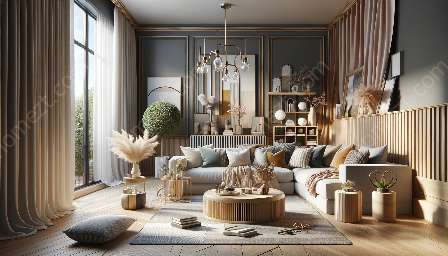When it comes to creating a stylish and harmonious home, integrating color in furniture and accessory selection is essential. The right colors can transform a space, evoke emotions, and reflect personal style. In this comprehensive guide, we'll explore the art of combining colors in furniture and accessories, aligning with various color schemes and palettes, and how to incorporate these techniques into homemaking and interior decor. Whether you're a novice or an experienced decorator, these tips and insights will help you add a pop of color in a way that is attractive and real.
Understanding Color Schemes and Palettes
Before delving into the practical aspects of integrating color into furniture and accessory selection, it's crucial to understand the fundamentals of color schemes and palettes. Color schemes are predefined combinations of colors that work well together. They can be broadly categorized into the following types:
- Monochromatic: This scheme involves using different shades, tints, and tones of a single color. It creates a cohesive and elegant look.
- Analogous: Analogous color schemes consist of colors that are adjacent to each other on the color wheel. They provide a sense of harmony and are pleasing to the eye.
- Complementary: Complementary colors are opposite each other on the color wheel. When used together, they create a vibrant and dynamic visual impact.
- Triadic: Triadic color schemes involve three colors that are evenly spaced around the color wheel. They offer a balanced and lively color combination.
- Split-Complementary: This scheme is similar to the complementary scheme but uses a base color and the two colors adjacent to its complementary color.
On the other hand, color palettes are a selection of colors used in a specific design. They can be warm, cool, neutral, or vibrant, catering to different moods and styles. Understanding these principles serves as a solid foundation for choosing the right colors for furniture and accessories.
Integrating Colors in Furniture Selection
When selecting furniture, it's essential to consider how color can enhance the overall aesthetic of a room. Here are some strategies for integrating color into furniture selection:
- Statement Piece: Choose a bold, colorful furniture item such as a sofa, accent chair, or cabinet as a focal point in the room. This allows the color to anchor the space and create a visual impact.
- Color Blocking: Incorporate contrasting or complementary colors in different furniture pieces to add visual interest. For instance, pair a deep blue armchair with a mustard yellow ottoman to create a striking contrast.
- Accent Details: Look for furniture with colored accents like piping, upholstery, or intricate patterns. These subtle pops of color can enliven the space without overwhelming it.
- Texture and Finish: Consider the texture and finish of furniture pieces in addition to color. A glossy finish can reflect light and make a space feel brighter, while matte textures can add depth and warmth.
Accessorizing with Color
Accessories play a crucial role in adding personality and charm to a home. When it comes to integrating color through accessories, the following tips can be helpful:
- Color Harmonization: Select accessories such as throw pillows, rugs, and curtains that echo the colors of the furniture or walls, creating a cohesive color palette throughout the space.
- Pop of Contrast: Introduce a pop of contrasting color through accessories to create visual interest. For example, a vibrant orange throw on a neutral-toned sofa can instantly uplift the room.
- Artwork and Décor: Integrate artwork, vases, and other decorative items in complementary colors to tie the room together. These accents can serve as focal points and conversation starters.
- Nature-Inspired Hues: Embrace nature-inspired color schemes by incorporating greens, blues, and earthy tones through plants, floral arrangements, and natural materials like wood and stone.
Aligning with Homemaking and Interior Decor
Integrating color in furniture and accessory selection extends beyond mere aesthetics. It aligns with the principles of homemaking and interior decor, creating a space that is vibrant, inviting, and reflective of personal style and preferences.
Creating an Inviting Environment
Mixing and matching colors thoughtfully creates an inviting and welcoming atmosphere. A well-balanced color scheme can make a home feel comforting and appealing, encouraging relaxation and fostering positive emotions.
Expressing Personal Style
Color serves as a medium for self-expression. By selecting furniture and accessories in colors that resonate with your personality and preferences, you can infuse your home with your unique style, creating a space that feels distinctly yours.
Enhancing Functionality
Color can also affect the functionality of a space. For instance, using calming and soothing colors in a bedroom can promote relaxation, while vibrant and energetic colors in a workspace can boost productivity and creativity.
Reflecting Seasons and Trends
Integrating color allows for flexibility in updating and refreshing a space according to changing seasons and design trends. By swapping out accessories or incorporating seasonal hues, you can keep your home in tune with the latest color palettes and styles.
Conclusion
Integrating color in furniture and accessory selection is a delightful and meaningful endeavor. It involves understanding color schemes and palettes, selecting furniture with a keen eye for color, and accentuating the space with carefully curated accessories. By aligning these techniques with homemaking and interior decor principles, you can transform your living space into a harmonious and stylish oasis.


